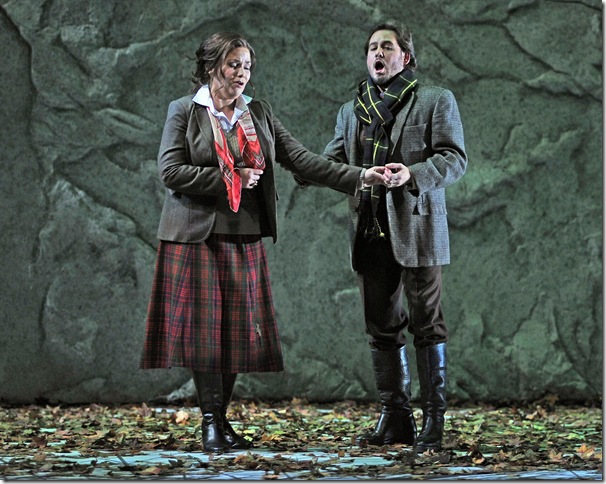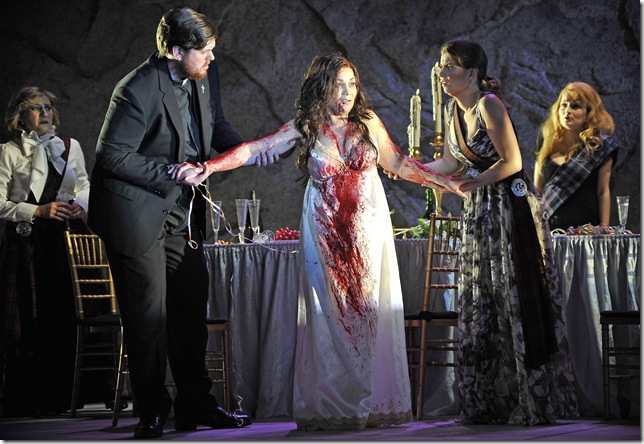Florida Grand Opera’s current production of Gaetano Donizetti’s Lucia di Lammermoor has reimagined this opera in a way that falls short of success, but fortunately it does have a soprano in the lead role whose singing is strong enough to carry the heavy lifting of the Mad Scene and much else besides.
Eglise Gutiérrez, a Cuban-born soprano now resident in Philadelphia, has made something of a name for herself in the past two or three years as a reliable Lucia, and the audience Sunday at the Ziff Ballet Opera House in downtown Miami heard why that is: Gutiérrez has a big, dark, voice that commands attention, and it’s wielded with exceptional breath control.
This is a singer with serious stamina. Time after time, Gutiérrez was able to spin out the scales and roulades of the bel canto style with unbroken smoothness, and then find the breath to attack the next hurdle with no sign of strain. In the Mad Scene, she sang masterfully overall, including very precise work with the solo flute, and only in her very last bravura high notes was it evident that her voice was beginning to tire.
But before that, she vocally dominated the action, and that was all to the good, because the production itself tries too hard to be innovative. The Franco-Canadian team of director Renaud Doucet and set designer André Barbe are in charge of all the FGO productions this season, and for Lucia they have come up with something that might have worked with a different approach, but that is now odd and somewhat clumsy.
The time of this Lucia has been changed roughly to modern dress, though the setting of aristocratic Scotland, one in which wealthy men find kilts de rigueur. A large, rocky wall meant to symbolize the barriers between the feuding Ashton and Ravenswood families takes up much of the stage in all three acts, and it works reasonably well as a dramatic device and scene-setter.
But Doucet has decided to foreshadow the tragic denouement by giving us a hint of blood: At the end of the first act, as Lucia and Edgardo part by the fountain, the lights go out, then come back on to focus on a woman in a blood-soaked gown, standing in the water.
In the second act, as the action and music build to the great sextet that ends the act – Chi mi frena in tal momento? – the woman in the gown appears again, walking slowly on the big dining table in the middle of the guests, then going up to the performers while they’re singing in a kind of literal memento mori. It was especially annoying Sunday because the best ensemble singing in the whole opera was taking place, and it was hard to enjoy it while wondering whether that strange woman was going to have the good grace to sit down, already, and leave everyone alone.
But to give Doucet the benefit of the doubt, it’s not a terrible idea; it’s just one that probably would have worked better as a projection, a trick of video, rather than as a job for a supernumerary. That way it could be more mysterious, less intrusive and less risible.
As Edgardo, the Spanish tenor Israel Lozano turned in an uneven performance Sunday. His is a pleasant, not overly forceful voice, and it sounded best in the Act I duet with Lucia (Verranno a te sull’aure) and his Fra poco me ricovero at the end. He cuts a nice figure on stage, as well, but his voice essentially gave out in the last few minutes of the opera, and his high notes in the final passages were painfully strained.
As Enrico, baritone Mark Walters was quite good, with a strong, clear voice in Cruda funesta smania, and a stage presence that won him affectionate boos at the curtain call. He and Jordan Bisch, as Raimondo, set the opera on its way in strong fashion in the first act. Bisch has a deeper, cloudier voice than Walters, but it has dignity and warmth, and he sang well throughout the opera in a killjoy role.
The other men – Jonathan Michie as Normanno and David Bailey as Arturo – were not terribly effective, nor was Amanda Crider as Alisa, though all three of these roles don’t give the singers enough to do to make a larger impact. Ramón Tebar, a fine conductor, proved it Sunday, accompanying with taste and restraint. His orchestra was shaky at first, particularly in the horns, but it got better as the afternoon went on, and ultimately did a good job with Donizetti’s score.
The choral singing, prepared by John Keene, was very accomplished for the most part, particularly in the Act II sextet and that catchy choral song, Per te d’immenso giubilo. Barbe’s costumes were high-end-catalog handsome, and Gordon Olson’s lighting had a late-afternoon moodiness that helped foreshadow the lamentable events on stage.
It’s worth seeing this production for Gutiérrez, and for the high level of musicianship on display from Walters, Bisch and the massed chorus in some parts of the opera. I don’t think the staging idea will survive this production, but it was an interesting attempt, and makes this Lucia memorable for reasons besides its soprano’s big moment.
Lucia di Lammermoor can be seen at 8 p.m. Thursday and Sunday at the Broward Center for the Performing Arts, Fort Lauderdale. Eglise Gutiérrez is Lucia, Israel Lozano is Edgardo, and Mark Walters is Enrico. Ramón Tebar conducts. Tickets: $21-200. Call 800-741-1010 or visit www.fgo.org.

